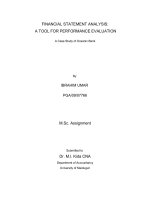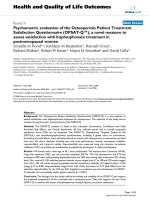Q a schweser self test 09 performance evaluation answers
Bạn đang xem bản rút gọn của tài liệu. Xem và tải ngay bản đầy đủ của tài liệu tại đây (162.37 KB, 5 trang )
Question #1 of 12
C) lacks statistical reliability.
Explanation
McDaniel's returns-based benchmark is likely not a valid benchmark because it is not statistically
reliable. She uses only 12 data points (the monthly returns over the past year), and this is not
enough data points to generate a statistically reliable model. Returns-based benchmarks are
measurable, investable, and unambiguous.
Question #2 of 12
B) both are incorrect.
Explanation
McDaniel is incorrect. Although the null hypothesis is stated correctly (the manager adds no value),
McDaniel's definition of a Type I error is incorrect. A Type I error is when the null hypothesis is
rejected when it is true. Peterson is also incorrect. A Type II error is failure to reject the null when it is
false.
Question #3 of 12
C) only one is correct.
Explanation
McDaniel is correct. One advantage to using a returns-based benchmark is that it is useful where the
only information available is account returns. Peterson is incorrect. Returns- based benchmarks are
generally easy to use and intuitive.
Question #4 of 12
C) Yes, in both capital goods and financial sectors.
Explanation
To answer this question, we must first examine the return for the overall benchmark versus the
return for the benchmark in both sectors. The overall return for the benchmark is given at 0.86%.
The capital goods sector return in the benchmark was -5.00%. For the financial sector, it was 4.00%.
Thus, relative to the overall benchmark return of 0.86%, the capital goods sector was an
underperforming sector and the financial sector outperformed. Now determine whether Matson
overweighted or underweighted each sector. He underweighted the weak capital goods sector
(8.00% allocation for the manager versus 9.00% for the benchmark), and he overweighted the
strong financial sector (20.00% allocation for the manager versus 18.00% for the benchmark).
Because Matson underweighted a weak sector and he overweighted a strong sector, he made
correct decisions for both.
No calculations are needed to reach the above conclusions. However, the sector allocation returns
can be calculated by multiplying the difference between the portfolio and benchmark allocation by
the difference in sector benchmark return and overall benchmark return for each sector. For the
capital goods sector, it is (8.0% - 9.0%) × (-5.00% - 0.86%) = 0.0586%. For the financial sector, it is
(20.0% - 18.0%) × (4.00% - 0.86%) = 0.0628%.
Question #5 of 12
B) Yes, but only in the technology sector.
Explanation
To answer this question, examine the return for the manager against the return for the benchmark in
each sector. Matson's return in the consumer durables sector was 2% versus 3% for the benchmark,
so he did not outperform the benchmark for security selection in this sector. However, the return for
the manager in the technology sector was 2.6% versus -2% for the benchmark, so he did outperform
the benchmark for security selection in this sector.
No calculations are needed to reach the above conclusions. However, the within-sector allocation
returns can be calculated by multiplying the difference between the portfolio and benchmark return in
each sector by the benchmark's weight. For the consumer durables sector, it is (2.0% - 3.0%) × 35%
= -0.35%. For the technology sector, it is (2.6% + 2.0%) × 16% = 0.736%.
Question #6 of 12
B) Yes, in both agricultural and utilities sectors.
Explanation
To answer this question, multiply the difference in weightings for the manager and the benchmark by
the difference in returns for the manager and the benchmark in each sector. In the agricultural
sector, this is (4% - 6%) × (-2% + 1%) = 0.02%. In the utilities sector, this is (12% - 10%) × (4% +
2%) = 0.12%.
Question #7 of 12
B) both are incorrect.
Explanation
Willis is incorrect. Endowments are not taxable entities so the tax advantage of the municipal bonds
is not a valid reason for the endowment to consider the municipal bonds. Dunn is incorrect.
Endowments typically have a high ability and willingness to take risk because of their infinite time
horizon. It is also imprudent for Dunn to state whether an investment is appropriate for National until
he has reviewed the investment policy statement.
Question #8 of 12
C) 6.70%.
Explanation
The M-squared measure for the Jaguar fund is 11.11%.
To calculate the M-squared ratio for Jaguar, use the following formula:
Comparing the 11.11% to the return on the market of 10%, the Jaguar fund has superior
performance. The M-squared measure for the Theta fund is 11.22%, which indicates that the Theta
fund has superior performance relative to both the market and Jaguar fund.
Question #9 of 12
B) 0.32.
Explanation
The Sharpe ratio for Theta would be calculated as:
The Sharpe ratio for the Jaguar fund is 0.31, which indicates that the Theta fund has superior
performance relative to the Jaguar fund.
Question #10 of 12
C) 9.1.
Explanation
The Treynor ratio for Theta would be calculated as:
The Treynor ratio for the Jaguar fund is 15.0, which indicates that the Jaguar fund has superior
performance relative to the Theta fund.
Question #11 of 12
B) 7.6%.
Explanation
The ex post alpha for Jaguar would be calculated as:
The ex post alpha for the Theta fund is 4.5%, which indicates that the Jaguar fund has superior
performance relative to the Theta fund.
Question #12 of 12
C) only one is correct.
Explanation
Willis is correct. By the Sharpe ratio and M-squared measures, which use total risk (standard
deviation), the Theta fund has superior performance. By the Treynor ratio and ex post alpha, which
use systematic risk (beta), the Jaguar fund has superior performance. The discrepancy is because
the Jaguar fund is poorly diversified. Dunn is incorrect. National's current endowment is well
diversified and thus the appropriate measure of risk for additional investments would be beta.
Because the Jaguar fund has a better Treynor ratio and ex post alpha, it is the better fund to add to
the endowment.









